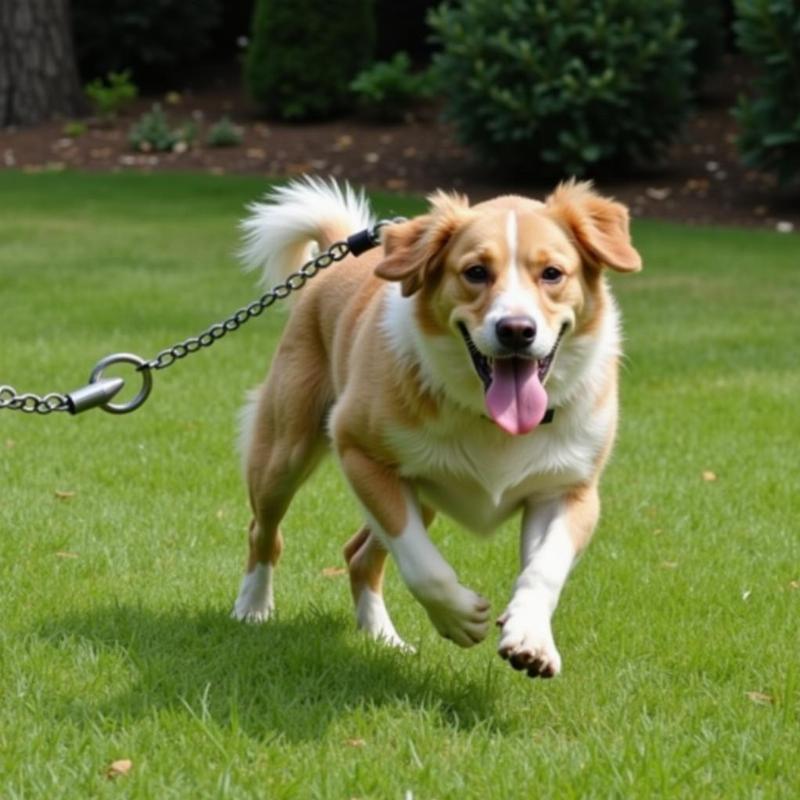Chain tie outs are a common method of restraining dogs outdoors, but their use is surrounded by controversy. Understanding the potential risks and benefits, along with responsible alternatives, is crucial for any dog owner considering a chain tie out. This guide will help you navigate the complex landscape of chain tie outs for dogs and make informed decisions that prioritize your dog’s well-being.
Are Chain Tie Outs Humane? Exploring the Ethical Concerns
While convenient, chain tie outs raise serious ethical questions about a dog’s physical and mental health. Long-term chaining can lead to behavioral problems like aggression, anxiety, and frustration due to restricted movement and social isolation. It can also cause physical harm, such as neck and leg injuries from entanglement or the chain itself. Many animal welfare organizations and veterinarians strongly discourage the use of chain tie outs for these reasons.
State Regulations and Local Ordinances on Tethering Dogs
The legality of chaining dogs varies across the United States. Some states and local jurisdictions have specific regulations or outright bans on tethering, particularly long-term chaining. These laws often address the type of tether allowed, its length, and the required shelter and access to water. Before using a chain tie out, it’s essential to research and comply with local laws in your area to avoid penalties. The American Society for the Prevention of Cruelty to Animals (ASPCA) provides resources for understanding tethering laws in different states.
Safer Alternatives to Chain Tie Outs for Your Dog
Fortunately, several safer and more humane alternatives exist for managing your dog outdoors. These options prioritize your dog’s physical and mental well-being while ensuring their safety:
- Fences: Installing a secure fence in your yard provides your dog with a safe and defined space to roam freely and enjoy the outdoors.
- Trolleys and Zip Lines: These systems allow dogs a greater range of movement along a designated line, reducing the risks associated with traditional tie outs.
- Exercise Pens: Portable exercise pens create a temporary enclosure, ideal for supervised outdoor time or when traveling.
- Supervised Outdoor Time: The best way to ensure your dog’s safety and happiness is through regular, supervised outdoor play and exercise. This allows for bonding, training, and prevents the negative impacts of isolation.
 Dog Enjoying Trolley System
Dog Enjoying Trolley System
Choosing the Right Tie Out (If Absolutely Necessary): Material, Length, and Safety Considerations
If a tie out is absolutely unavoidable as a short-term solution, prioritize your dog’s safety and comfort by selecting the appropriate type and using it responsibly:
- Material: Opt for lightweight, weather-resistant materials like nylon or coated steel cables over heavy chains, which can pose a greater risk of injury.
- Length: The tether should be long enough to allow your dog adequate space to move and access necessities like water and shade but not so long that it becomes a tangling hazard.
- Swivel: A swivel attachment prevents the tie out from twisting and becoming tangled, reducing the risk of strangulation.
- Supervision: Never leave a tethered dog unsupervised for extended periods.
Chain Tie Out FAQs
- Are chain tie outs illegal in the US? While not universally illegal, many areas have regulations restricting or banning their use, especially long-term chaining. Check your local laws.
- What are the risks of using a chain tie out? Risks include physical injuries, behavioral problems, and decreased quality of life due to restricted movement and social isolation.
- What are better alternatives to a chain tie out? Fences, trolleys, supervised playtime, and exercise pens are humane options.
- What should I look for in a tie out if I must use one? Choose lightweight materials, an appropriate length, a swivel attachment, and always supervise your dog.
- Can a chain tie out be used for training? No, tie outs are not suitable for training and can hinder socialization and create behavioral issues.
- How can I find out about tethering laws in my area? Contact your local animal control or check resources like the ASPCA website.
- What can I do if I see a dog chained up in inhumane conditions? Report it to your local animal control or humane society.
Conclusion
While chain tie outs might seem like a convenient solution for managing your dog outdoors, they pose significant risks to a dog’s physical and mental well-being. By understanding the ethical considerations, exploring safer alternatives, and familiarizing yourself with local laws, you can make responsible choices that prioritize your dog’s safety, happiness, and overall quality of life.
best dog food for german shorthaired pointer puppy
cost of dog nail trim
dog clipper guide combs size chart mm
how do i know if my dog has toothache
Beautdogs.us is your premier resource for comprehensive and trustworthy information on dog care, breed specifics, and product recommendations in the United States. We cater to both new and experienced dog owners, offering expert advice to ensure the well-being of your canine companion. From nutrition and grooming to training and health, Beautdogs.us equips you with the knowledge and resources you need to be the best dog parent you can be. Contact us today for personalized support: Email: [email protected], Phone: +1 501-555-7529.